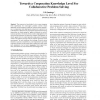120 search results - page 13 / 24 » Merging partial behavioural models |
BIRTHDAY
2000
Springer
14 years 2 months ago
2000
Springer
Bistructures are a generalisation of event structures which allow a representation of spaces of functions at higher types in an orderextensional setting. The partial order of caus...
ERSHOV
2006
Springer
14 years 1 months ago
2006
Springer
Abstract. Two formal models for description of timing attacks are presented, studied and compared with other security concepts. The models are based on a timed process algebra and ...
BMCBI
2010
13 years 10 months ago
2010
Background: A growing demand for tools to assist the building and analysis of biological networks exists in systems biology. We argue that the use of a formal approach is relevant...
APN
2007
Springer
14 years 4 months ago
2007
Springer
In this work, we propose two high-level formalisms, Markov Decision Petri Nets (MDPNs) and Markov Decision Well-formed Nets (MDWNs), useful for the modeling and analysis of distrib...
ECAI
1992
Springer
14 years 1 months ago
1992
Springer
The cooperation knowledge level is a new computer level specifically for multi-agent problem solvers which describes rich and explicit models of common social phenomena. A cooperat...

